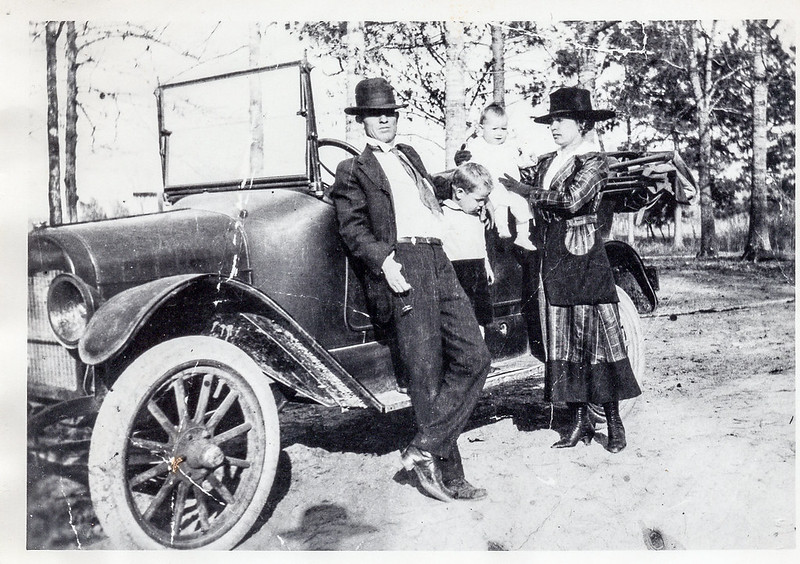Leona 'Granny' Ginn
Leona Ginn was no stranger to tragedy. She lost her first husband, A.J. Wells, and youngest child in a flu epidemic circa 1912. In 1914, she married Jesse Ginn and moved to Houston from Groveton in Trinity County. Along with her oldest son from her first marriage, Leona and Jesse would add six more children – five sons and a daughter – to their family over the next 15 years.
Jesse came from Tennessee, following his family to East Texas where the timber industry was booming. He worked as a lumberman, carpenter and mule driver. The work was dangerous and dirty and, like many laborers of that time, Jesse made do with only four fingers on his right hand, having lost his index finger in an accident. In pictures from the era, Jesse subtly but proudly displays the hand like a badge of honor.
 Jesse and Leona Ginn 1917
Jesse and Leona Ginn 1917
Photo courtesy Ginn Family
After moving to Houston, Jesse worked as a machinist and later as a watchman (security guard) for the Texas Company (later Texaco) – jobs that were more stable and safer than his previous line of work. Leona worked as a homemaker and raised the children.
As the kids grew older, one of Jesse’s favorite pastimes was to take the two oldest sons, Albert and Hubert, hunting for pecans and squirrels near Liberty, just northeast of Houston.
On Nov. 9, 1933, Jesse, Hubert and Albert were returning from a hunting trip and driving on the Old Beaumont Highway, now Highway 90, when their car was rear-ended by a truck loaded with heavy machinery. Jesse was killed instantly, Albert suffered a fractured pelvis, and Hubert had scrapes and bruises. The driver of the truck, Shannon Moreaux of Houston, was uninjured.
The cause of the accident was always in dispute. The truck driver claimed his steering failed. But Houstonian Russell Ginn – Albert’s son – still has a beer bottle that Hubert grabbed from the truck after the accident as evidence the driver was impaired.
Whatever the cause of the accident, Leona Ginn found herself the single mother of seven children during the depths of the Great Depression. How would she support her family?
The answer can be found in the 1934 Houston City Directory that lists “Leona Ginn (widow Jesse), Green Hut Café, 1805 E. Quitman St.”
 Leona Ginn at The Green Hut Cafe ca 1934
Leona Ginn at The Green Hut Cafe ca 1934
Photo courtesy the Ginn Family
Leona had leveraged her many years cooking for her family to open a small cafe just north of downtown. Pictures provided by her grandson, A.C. “Sparky” Ginn of Houston, show a ramshackle wood structure that looks like it might blow over in a strong gust of wind. Fortunately, it is anchored in one corner by a remarkable barbecue pit – a vertical brick smoker with a tall flue, a clean-out door facing the sidewalk, and a firebox door on the side and bottom for adding wood and stoking the fire.
Signs propped on top of the roof advertise Grand Prize Beer (“Finest in the South!”), Dr Pepper (“Good for Life”) and “Bar-B-Q Meals.” A sandwich board on the sidewalk lists “Bar-BQ lunches” for 25 cents and barbecue sandwiches (usually chopped beef covered in barbecue sauce) for 15 cents.
Leona was head cook and pitmaster; other family members also contributed. A young Hubert Ginn, all of 17 years old, was listed as a “manager” in later city directories.
By 1935, the Green Hut Café had become successful to the point that Leona opened a second lunch stand at the Port City Stock Yards – a livestock market near the Port of Houston.
In 1937, she opened Ginn’s Café at 915 San Jacinto. This was a more upscale restaurant in a bustling area of downtown. According to grandson Russell Ginn, the location was next to a Hudson car dealership, which provided a loyal customer base.
“Once the Hudson dealership closed, the cafe slowly went downhill,” says Ginn. By 1940, all three locations had closed.
Fortunately, Leona had previously collected an insurance settlement for Jesse’s death. Grandsons A.C. and Russell – who fondly refer to her as “Granny” Ginn – believe she probably collected the equivalent of hundreds of thousands of dollars in today’s money. Who could blame Leona for closing down the restaurants so she could once again take care of her family?
If the history of Houston barbecue is ever written, the title should probably include the phrase “Necessity is the mother of invention.” The rise of Houston barbecue in the 1920s and ’30s was not driven by pitmasters wanting to produce craftsmanlike or artisanal-style barbecue. It was driven by enterprising Houstonians who needed to make a living during tough economic times.
Barbecue offered entrepreneurs a low barrier to entry as well as a customer base familiar with and fanatical about smoked meats. Leona Ginn and the Green Hut Café are a perfect example of how barbecue became part of the business and culinary traditions of Houston.

